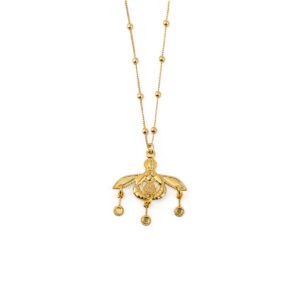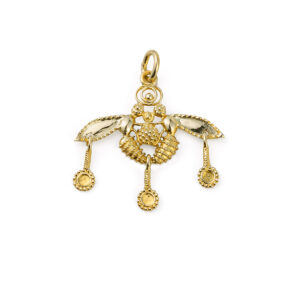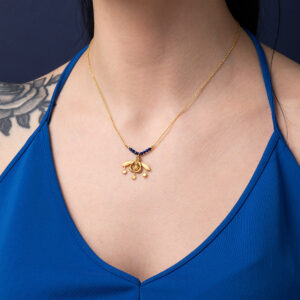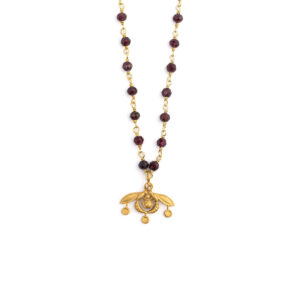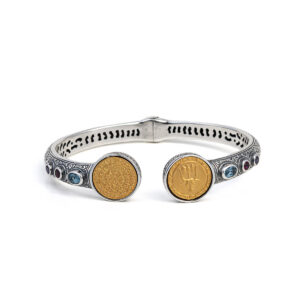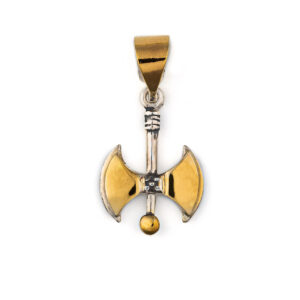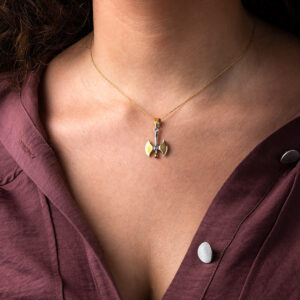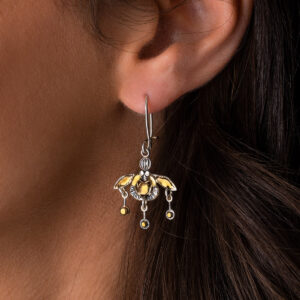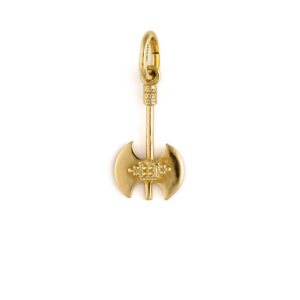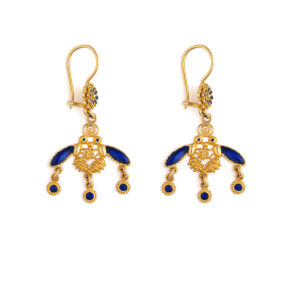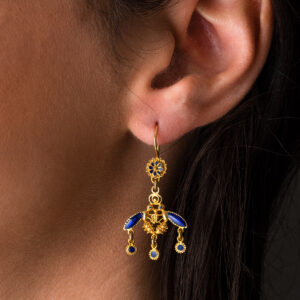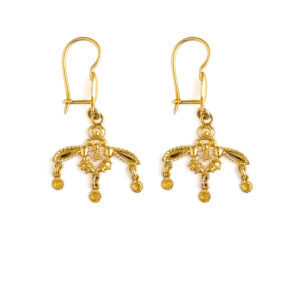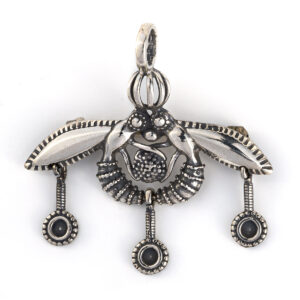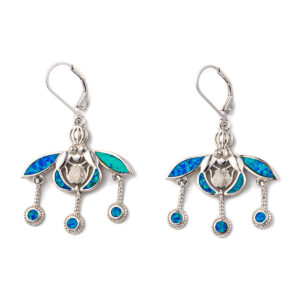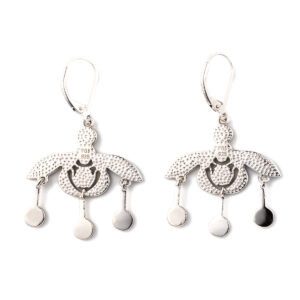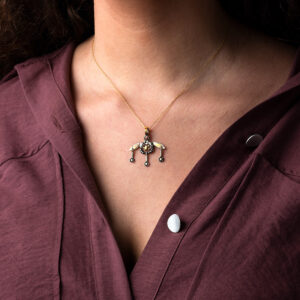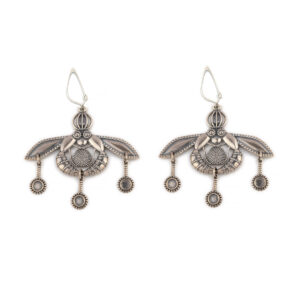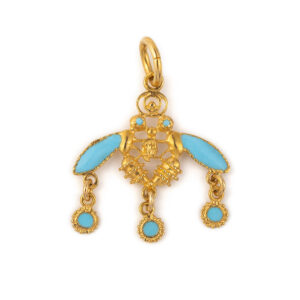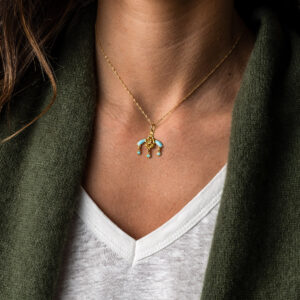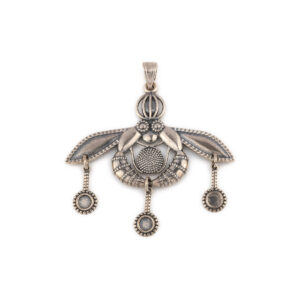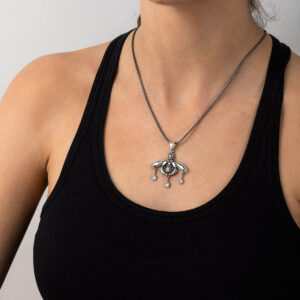Η αρχαία Ελλάδα ξαναζωντανεύει μέσα από τα κοσμήματα αυτής της συλλογής. Μύθοι, ιστορικά γεγονότα και πρόσωπα, μοναδικές αρχιτεκτονικές εμπνευσμένες από την Ελληνική κληρονομιά ζωντανεύουν μέσα από περίτεχνες τεχνικές της ελληνικής χρυσοχοΐας που κληρονομήσαμε από τους προγόνους μας.
Κολιέ Μινωική Μέλισσα – Επιχρυσωμένο Aσήμι 925
Από επιχρυσωμένο ασήμι 925°.
Χειροποίητο ελληνικό κόσμημα.
Ανακαλύψτε τη Συλλογή Κληρονομιά
Ιστορία
Το μενταγιόν με τη μέλισσα των Μαλίων ανακαλύφθηκε στο Χρυσόλακκο, του μινωικού παλατιού των Μαλίων στο νησί της Κρήτης, και πιστεύεται ότι χρονολογείται γύρω στο 1800 π.Χ.. Το όνομα Χρυσόλακκος σημαίνει “λάκκος του χρυσού” λόγω των πολύτιμων αντικειμένων που συνήθιζαν να βρίσκουν εκεί οι γεωργοί. Το Μινωικό Ανάκτορο βρίσκεται 3 χλμ. ανατολικά της πόλης των Μαλίων και είναι το τρίτο σημαντικότερο γνωστό μινωικό ανάκτορο μετά την Κνωσό και τη Φαιστό. Αυτό το μενταγιόν έχει το σχήμα δύο μελισσών ή σφηκών, που αποθηκεύουν μια σταγόνα μέλι σε μια κηρήθρα και είναι ένα από τα πιο διάσημα εκθέματα του Μουσείου Ηρακλείου.
Κολιέ Μινωικές Μέλισσες – Επιχρυσωμένο Aσήμι 925
Από επιχρυσωμένο ασήμι 925°.
Χειροποίητο ελληνικό κόσμημα.
Ανακαλύψτε τη Συλλογή Κληρονομιά
Ιστορία
Το μενταγιόν με τη μέλισσα των Μαλίων ανακαλύφθηκε στο Χρυσόλακκο, του μινωικού παλατιού των Μαλίων στο νησί της Κρήτης, και πιστεύεται ότι χρονολογείται γύρω στο 1800 π.Χ.. Το όνομα Χρυσόλακκος σημαίνει “λάκκος του χρυσού” λόγω των πολύτιμων αντικειμένων που συνήθιζαν να βρίσκουν εκεί οι γεωργοί. Το Μινωικό Ανάκτορο βρίσκεται 3 χλμ. ανατολικά της πόλης των Μαλίων και είναι το τρίτο σημαντικότερο γνωστό μινωικό ανάκτορο μετά την Κνωσό και τη Φαιστό. Αυτό το μενταγιόν έχει το σχήμα δύο μελισσών ή σφηκών, που αποθηκεύουν μια σταγόνα μέλι σε μια κηρήθρα και είναι ένα από τα πιο διάσημα εκθέματα του Μουσείου Ηρακλείου.
Μενταγιόν Μινωικές Μέλισσες – Επιχρυσωμένο Aσήμι 925
Από επιχρυσωμένο ασήμι 925°.
Χειροποίητο ελληνικό κόσμημα.
Ανακαλύψτε τη Συλλογή Κληρονομιά
Ιστορία
Το μενταγιόν με τη μέλισσα των Μαλίων ανακαλύφθηκε στο Χρυσόλακκο, του μινωικού παλατιού των Μαλίων στο νησί της Κρήτης, και πιστεύεται ότι χρονολογείται γύρω στο 1800 π.Χ.. Το όνομα Χρυσόλακκος σημαίνει “λάκκος του χρυσού” λόγω των πολύτιμων αντικειμένων που συνήθιζαν να βρίσκουν εκεί οι γεωργοί. Το Μινωικό Ανάκτορο βρίσκεται 3 χλμ. ανατολικά της πόλης των Μαλίων και είναι το τρίτο σημαντικότερο γνωστό μινωικό ανάκτορο μετά την Κνωσό και τη Φαιστό. Αυτό το μενταγιόν έχει το σχήμα δύο μελισσών ή σφηκών, που αποθηκεύουν μια σταγόνα μέλι σε μια κηρήθρα και είναι ένα από τα πιο διάσημα εκθέματα του Μουσείου Ηρακλείου.
Μενταγιόν Μινωική Χρυσή Μέλισσα από 14Κ Χρυσό
442,00€Εμπνευσμένο από τις αρχαιοελληνικές μινωικές μέλισσες στα Μάλια.
Κατασκευασμένο από χρυσό 14Κ.
Χειροποίητο ελληνικό κόσμημα.
Ανακαλύψτε τη Συλλογή Κληρονομιά
Το μενταγιόν των μινωικών μελισσών, ένα από τα πιο διάσημα μινωικά έργα τέχνης, ανακαλύφθηκε στο νεκροταφείο του Παλαιού Ανακτόρου στο Χρυσόλακκο, έξω από το ανάκτορο των Μαλίων, το τρίτο μεγαλύτερο και σημαντικότερο γνωστό μινωικό ανάκτορο μετά την Κνωσσό και τη Φαιστό. Χρυσόλακκος σημαίνει “Λάκκος του χρυσού” λόγω των πολλών πολύτιμων αντικειμένων που βρέθηκαν εκεί. Το διάσημο μενταγιόν χρονολογείται από την Εποχή του Χαλκού, (1800 π.Χ.) και είναι μια εκπληκτική, πολύ λεπτομερής αναπαράσταση δύο μελισσών ή σφηκών που αποθηκεύουν μια σταγόνα μέλι στην κηρήθρα τους. Αυτό το μενταγιόν είναι ένα από τα πιο διάσημα εκθέματα στο θαυμαστό αρχαιολογικό μουσείο του Ηρακλείου.
Κολιέ Ροζάριο με Πέτρες και Μέλισσα – 925 Ασήμι
Φτιαγμένο από ασήμι 925 και επιχρυσωμένο.
Χειροποίητο Ελληνικό Κόσμημα
Ανακαλύψτε τη Συλλογή Κληρονομιά
Κολιέ Ροζάριο με Μέλισσα – Ασήμι 925
Φτιαγμένο από ασήμι 925 και επιχρυσωμένο.
Χειροποίητο Ελληνικό Κόσμημα
Ανακαλύψτε τη Συλλογή Κληρονομιά
Βραχιόλι Μανσέτα Δίσκος Φαιστού – Ασήμι 925
Κατασκευασμένο από ασήμι 925, επιχρύσωμα και κρύσταλλα.
Ο Δίσκος της Φαιστού είναι ένας δίσκος από πηλό από το μινωικό παλάτι της Φαιστού στο νησί της Κρήτης. Τώρα, το νησί της Κρήτης είναι μέρος της σύγχρονης Ελλάδας. Ο δίσκος ανακαλύφθηκε το 1908 από τον Ιταλό αρχαιολόγο Luigi Pernier στο μινωικό παλάτι της Φαιστού. Ακόμα και στις μέρες μας η αποκρυπτογράφηση του δεν είναι ξεκάθαρη, καθιστώντας το ένα από τα πιο διάσημα μυστήρια της αρχαιολογίας. Ο δίσκος έχει διάμετρο περίπου 15 εκατοστά και καλύπτεται και στις δύο πλευρές με μια σπείρα από σφραγισμένα σύμβολα. Ο δίσκος διαθέτει 241 μάρκες, που περιλαμβάνουν 45 ξεχωριστά σημάδια, τα οποία φτιάχτηκαν προφανώς πιέζοντας ιερογλυφικές «σφραγίδες» σε ένα δίσκο από μαλακό πηλό, με μια δεξιόστροφη ακολουθία που στρέφεται προς το κέντρο του δίσκου. Αυτό το μοναδικό αντικείμενο εκτίθεται τώρα στο αρχαιολογικό μουσείο Ηρακλείου.
Χειροποίητο ελληνικό κόσμημα.
Minoan Double Axe Pendant – 14K Yellow Gold and Sterling Silver
Pendant inspired by the Minoan double axe, known as labrys.
Made of 14K Gold and Sterling Silver
Handmade in Greece.
The chain shown is included.
Explore Heritage Collection
History
Labrys is, according to Plutarch, Minoan word for the double headed axe called in Greek πέλεκυς (pélekus). In ancient Crete, the double axe was an important sacred symbol of the Minoan religion. In Crete it never accompanies male gods, but always female goddesses. It seems that it associated with the worship of Mother Earth or Great Goddess.
Minoan Bees Earrings – 14K Gold and 925 Sterling Silver
The Minoan Bees Pendant, one of the most famous Minoan artworks, was discovered in the Old Palace cemetery at Chrysolakkos, outside the palace of Malia, the third largest and most significant known Minoan palace after Knossos and Phaistos. Chryssolakkos means the “Pit of gold” because of the many precious objects that were found there. The famous pendant dates back to the Bronze Age, (1800 BC) and it’s an stunning, very detailed representation of two bees or wasps storing away a drop of honey to their honeycomb. This pendant is one of the most famous exhibits in the wonderfully Heraklion archeological museum.
Made of 14K Gold and 925 Sterling Silver
Handmade item.
Minoan Double Axe Pendant – 14K Yellow Gold
170,00€ – 272,00€Pendant inspired by the Minoan double axe, known as labrys.
Made of 14K Gold.
Handmade item.
The chain shown is our 14K Gold Chain in Length 40cm (not included).
Explore Heritage Collection
Labrys is, according to Plutarch, Minoan word for the double headed axe called in Greek πέλεκυς (pélekus). In ancient Crete, the double axe was an important sacred symbol of the Minoan religion. In Crete it never accompanies male gods, but always female goddesses. It seems that it associated with the worship of Mother Earth or Great Goddess.
As in all handmade items there may be small differences in weight and dimensions and this is what makes them unique and precious.
Minoan Axe Pendant
170,00€ – 255,00€Pendant inspired by the Minoan double axe, known as labrys.
Made of 14K Gold.
Handmade item.
As in all handmade items there may be small differences in weight and dimensions and this is what makes them unique and precious.
The chain shown is our 14K Gold Chain in Length 40cm (not included).
Explore Heritage Collection
Labrys is, according to Plutarch, Minoan word for the double headed axe called in Greek πέλεκυς (pélekus). In ancient Crete, the double axe was an important sacred symbol of the Minoan religion. In Crete it never accompanies male gods, but always female goddesses. It seems that it associated with the worship of Mother Earth or Great Goddess.
Minoan Malia Bees Dangle Earrings – 18K Solid Yellow Gold and enamel
945,00€Dangle earrings inspired by the ancient Minoan Greek Malia bees pendant.
Made of 18K Gold.
Handmade item.
The Minoan Bees Pendant, one of the most famous Minoan artworks, was discovered in the Old Palace cemetery at Chrysolakkos, outside the palace of Malia, the third largest and most significant known Minoan palace after Knossos and Phaistos. Chryssolakkos means the “Pit of gold” because of the many precious objects that were found there. The famous pendant dates back to the Bronze Age, (1800 BC) and it’s an stunning, very detailed representation of two bees or wasps storing away a drop of honey to their honeycomb. This pendant is one of the most famous exhibits in the wonderfully Heraklion archeological museum.
As in all handmade items there may be small differences in weight and dimensions and this is what makes them unique and precious.
Minoan Malia Bees Dangle Earrings – 14K Solid Yellow Gold
544,00€Dangle earrings inspired by the ancient Minoan Greek Malia bees pendant.
Made of 14K Gold.
Handmade item.
The Minoan Bees Pendant, one of the most famous Minoan artworks, was discovered in the Old Palace cemetery at Chrysolakkos, outside the palace of Malia, the third largest and most significant known Minoan palace after Knossos and Phaistos. Chryssolakkos means the “Pit of gold” because of the many precious objects that were found there. The famous pendant dates back to the Bronze Age, (1800 BC) and it’s an stunning, very detailed representation of two bees or wasps storing away a drop of honey to their honeycomb. This pendant is one of the most famous exhibits in the wonderfully Heraklion archeological museum.
As in all handmade items there may be small differences in weight and dimensions and this is what makes them unique and precious.
Malia bees pendant and brooch in sterling silver
Made in 925⁰ sterling silver.
Handmade item.
The Malia honeybee pendant was discovered at Chryssolakkos, of the Minoan Palace of Malia on the island of Crete, and is thought to date to c.1800 BC. The named Chryssolakkos that means the “pit of gold” because of the precious objects that the farmers used to find there. The Minoan Palace is situated 3 km east of Malia town and is the third most significant known Minoan Palace after Knossos and Phaistos.
This pendant is in the shape of two bees.
Minoan Malia Bees Earrings – 925 Sterling Silver with Opal
Made of 925⁰ sterling silver with blue opal.
The Minoan Bees Pendant, one of the most famous Minoan artworks, was discovered in the Old Palace cemetery at Chrysolakkos, outside the palace of Malia, the third largest and most significant known Minoan palace after Knossos and Phaistos. Chryssolakkos means the “Pit of gold” because of the many precious objects that were found there. The famous pendant dates back to the Bronze Age, (1800 BC) and it’s an stunning, very detailed representation of two bees or wasps storing away a drop of honey to their honeycomb. This pendant is one of the most famous exhibits in the wonderfully Heraklion archeological museum.
Minoan Bees Pendant – 14k Gold and Sterling Silver
Greek Ancient Minoan Bees Pendant In 14k Gold and sterling silver 925°. The Malia honeybee pendant was discovered at Chryssolakkos, of the Minoan Palace of Malia on the island of Crete, and is thought to date to c.1800 BC. The named Chryssolakkos that means the “pit of gold” because of the precious objects that the farmers used to find there. The Minoan Palace is situated 3 km east of Malia town and is the third most significant known Minoan Palace after Knossos and Phaistos.
This pendant is in the shape of two bees, or wasps, storing away a drop of honey in a comb.
Made of 14k Gold and Sterling Silver
Handmade item.
Minoan Bees Pendant – 14k Gold and Sterling Silver
A pendant inspired by the ancient Minoan Greek Malia bees pendant.
Made of 14k Gold and sterling silver 925°.
Handmade in Greece.
History
The Malia honeybee pendant was discovered at Chryssolakkos, of the Minoan Palace of Malia on the island of Crete, and is thought to date to c.1800 BC. The named Chryssolakkos that means the “pit of gold” because of the precious objects that the farmers used to find there. The Minoan Palace is situated 3 km east of Malia town and is the third most significant known Minoan Palace after Knossos and Phaistos. This pendant is in the shape of two bees, or wasps, storing away a drop of honey in a comb. The Bees pendant is one of the most famous exhibits in the Herakleion Museum.
The chain shown is our Cable Chain – 925 Sterling Silver and Gold Plated (included).
Explore Heritage Collection
Greek Minoan Bees Earrings – 925 Sterling Silver
Greek Ancient Minoan Bees Earrings In Sterling Silver. The Minoan Bees Pendant, one of the most famous Minoan artworks, was discovered in the Old Palace cemetery at Chrysolakkos, outside the palace of Malia, the third largest and most significant known Minoan palace after Knossos and Phaistos. Chryssolakkos means the “Pit of gold” because of the many precious objects that were found there. The famous pendant dates back to the Bronze Age, (1800 BC) and it’s a stunning, very detailed representation of two bees or wasps storing away a drop of honey in their honeycomb. This pendant is one of the most famous exhibits in the wonderfully Heraklion archeological museum.
Made of 925 sterling silver.
Handmade item.
18K Xρυσό Μενταγιόν Μινωική Μέλισσα
330,00€Αυτό το μενταγιόν είναι σχεδιασμένο από χρυσό 18 καρατίων με τυρκουάζ/μπλε σμάλτο, εμπνευσμένο από το μινωικό μενταγιόν της Μέλισσας. Το μενταγιόν της μέλισσας των Μαλίων ανακαλύφθηκε στον Χρυσόλακκο, του μινωικού παλατιού των Μαλίων στο νησί της Κρήτης, και πιστεύεται ότι χρονολογείται γύρω στο 1800 π.Χ. Το όνομα Χρυσόλακκος σημαίνει “λάκκος του χρυσού” λόγω των πολύτιμων αντικειμένων που συνήθιζαν να βρίσκουν εκεί οι αγρότες. Το μινωικό ανάκτορο βρίσκεται 3 χλμ. ανατολικά της πόλης των Μαλίων και είναι το τρίτο πιο σημαντικό γνωστό μινωικό ανάκτορο μετά την Κνωσό και τη Φαιστό.
Αυτό το μενταγιόν έχει το σχήμα δύο μελισσών ή σφηκών, που αποθηκεύουν μια σταγόνα μέλι σε μια κηρήθρα και είναι ένα από τα πιο διάσημα εκθέματα του Μουσείου Ηρακλείου.
Χειροποίητο ελληνικό κόσμημα.
Η αλυσίδα που φαίνεται στην τρίτη εικόνα είναι η 14Κ στριφτή αλυσίδα μας (δεν περιλαμβάνεται).
Μενταγιόν Μέλισσα – Ασήμι 925
Greek Ancient Minoan Bees Pendant In Sterling Silver. The Malia honeybee pendant was discovered at Chryssolakkos, of the Minoan Palace of Malia on the island of Crete, and is thought to date to c.1800 BC. The named Chryssolakkos that means the “pit of gold” because of the precious objects that the farmers used to find there. The Minoan Palace is situated 3 km east of Malia town and is the third most significant known Minoan Palace after Knossos and Phaistos.
This pendant is in the shape of two bees, or wasps, storing away a drop of honey in a comb.
Available in gold.
Handmade item.
The chain shown is our 925 Sterling Silver Oxidised Wheat Chain (not included).



